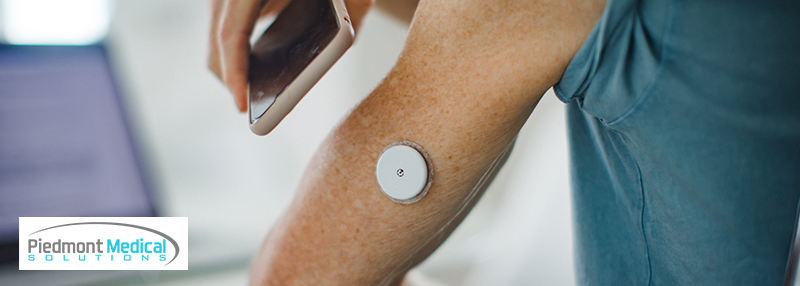Piedmont Medical Solutions
Updated Mon August 18, 2025
Published Under: Continuous Glucose Monitors Diabetes

If you or a loved one has recently been diagnosed with diabetes, you may have heard the term CGM, short for Continuous Glucose Monitor. You may be wondering, “What exactly is a CGM, and how can it help me manage my diabetes more effectively?”
In this guide, we’ll break down what a CGM is, how it works, and why it’s becoming a go-to management tool for people living with type 1 or 2 diabetes.
What Is a CGM?
A Continuous Glucose Monitor (CGM) is a small, wearable medical device that tracks your glucose (blood sugar) levels in real time. Unlike traditional fingerstick tests that give you a single reading, CGMs provide a continuous stream of data, helping you understand how your glucose levels change throughout the day and night.
This ongoing feedback helps you better understand the effects of:
- Food
- Physical activity
- Stress
- Medications
- Illness
By catching high and low glucose levels early, CGMs empower you to take action and avoid complications.
How Does a CGM Work?
A typical CGM system consists of three key components:
- Sensor: A small sensor is inserted just beneath the skin, usually on the belly or the back of the upper arm. It measures glucose levels in the interstitial fluid, which surrounds your body’s cells.
- Transmitter: The transmitter sits on top of the sensor and sends glucose data wirelessly to a receiver or smartphone.
- Display Device or App: You can view your real-time glucose data on a smartphone app, a dedicated reader, or a compatible insulin pump.
Many CGMs also include customizable alerts for high or low blood sugar levels. Some CGM models also allow you to share readings remotely with a caregiver or loved one, offering added peace of mind.
How Long Do CGM Sensors Last?
Most CGM sensors are worn for 7 to 15 days, depending on the brand. To find the right CGM for your lifestyle and insurance coverage, talk with your doctor and explore your options through Piedmont Medical Solutions’ diabetes supply services.
Top Benefits of Using a CGM
If you’re still using only fingersticks, here’s how switching to a CGM could improve your diabetes management:
- Fewer Fingersticks
Most CGMs are factory-calibrated, so you won’t need to check your levels multiple times a day with a test strip. - Real-Time Alerts
Get notified when your blood sugar is too high or low—before it becomes dangerous. - Better Data Insights
See how meals, stress, and sleep impact your blood sugar so you can make informed choices. - Improved A1C Control
Studies have shown that consistent CGM users see improvements in A1C, helping prevent long-term complications. - Remote Monitoring for Caregivers
With sharing features, family members and caregivers can track levels and respond quickly to dangerous changes.
Who Should Use a CGM?
CGMs can benefit many people with diabetes, especially those who:
- Have Type 1 diabetes
- Have Type 2 diabetes and use insulin
- Experience frequent hypoglycemia (low blood sugar)
- Need help managing dawn phenomenon or overnight glucose changes
- Are caregivers monitoring a loved one’s condition
- Want deeper insights to fine-tune their treatment plan
Get Your CGM from Piedmont Today
What to Expect When Starting a CGM
It’s normal to feel a little nervous at first, but with support from your care team and your CGM provider, it gets easier quickly and becomes second nature.
When you start using a CGM, your healthcare provider will help you:
- Learn how to insert and change the sensor
- Customize alerts and app settings
- Interpret your glucose trends
- Adjust your diet, activity, or medication based on the data
Piedmont Medical Solutions can also help walk you through setup, product selection, and insurance paperwork.
Contact Us for CGM Questions & Help
Are There Any Limitations?
CGMs are powerful, but they’re not flawless. Here are a few things to keep in mind:
- Data delay: CGMs measure glucose in interstitial fluid, not blood. There may be a slight delay during rapid blood sugar changes.
- Sensor errors or dislodging: Sensors can occasionally fall off or provide inaccurate readings if not placed or calibrated correctly.
- Medication interference: Common meds like acetaminophen (Tylenol) or high-dose vitamin C may interfere with some CGM readings. Always check compatibility.
- Backup plan required: Keep a blood glucose meter handy in case you need to verify data or your CGM malfunctions.
We're Here for You
A CGM can be a life-changing tool for people with diabetes. It provides real-time feedback, helps reduce dangerous episodes, and empowers users to make better decisions about their health every day.
If you’re newly diagnosed, or simply looking for a better way to manage your blood sugar, consider talking to your doctor about a CGM.
Need help getting started? Piedmont Medical Solutions can guide you through every step, from choosing the right CGM to handling insurance and reordering supplies. Contact us to learn more or visit our Diabetes Supplies page for more information.

Comments